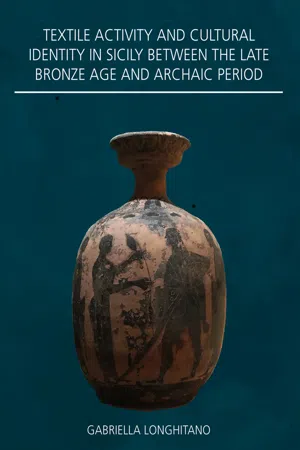
Textile Activity and Cultural Identity in Sicily Between the Late Bronze Age and Archaic Period
- 192 pages
- English
- ePUB (mobile friendly)
- Available on iOS & Android
Textile Activity and Cultural Identity in Sicily Between the Late Bronze Age and Archaic Period
About this book
Clothing was an essential part of material culture in ancient societies both as a form of body protection and as house equipment. Besides a practical function, textiles played a crucial role in communicating various aspects of social and personal identity. Based largely on the analysis of textile tools, this book is intended to be the first systematic attempt at reconstructing textile culture in ancient Sicily. Textile implements represent the most abundant category of evidence for textile activity in Sicily and in this book they are used as a means to explore the social dynamics within cultural interactions in the final Bronze–Iron Age and Archaic Sicily. The book begins with an overview of the cultural complexity of communities in Sicily and the Aeolian islands, focusing on two crucial periods of Sicilian history, which are characterised by intense movements of peoples from the Italian peninsula and the establishment of Greek and Phoenician settlements. Through the investigation of textile tools, the book discusses several key aspects, including technological features of textile technology and production, knowledge transfer, networks of weavers, as well as the social significance of textile activity. By employing an interdisciplinary perspective, this book is important not only for textile specialists but also for scholars and students dealing with culturally hybrid frameworks of ancient Sicily and provides a springboard for future studies on textile culture and cultural interactions in the ancient world.
Frequently asked questions
- Essential is ideal for learners and professionals who enjoy exploring a wide range of subjects. Access the Essential Library with 800,000+ trusted titles and best-sellers across business, personal growth, and the humanities. Includes unlimited reading time and Standard Read Aloud voice.
- Complete: Perfect for advanced learners and researchers needing full, unrestricted access. Unlock 1.4M+ books across hundreds of subjects, including academic and specialized titles. The Complete Plan also includes advanced features like Premium Read Aloud and Research Assistant.
Please note we cannot support devices running on iOS 13 and Android 7 or earlier. Learn more about using the app.
Information
Chapter 1
Geographical, chronological and cultural framework
Geographical context

Chronological and cultural context
 | ||
| Years BC | Italian terminology | Sicilian terminology |
 | ||
| 1450–1270 | Middle Bronze Age | Middle Bronze Age (Thapsos/Milazzese) |
| 1270–1150 | Recent Bronze Age | Late Bronze Age: Pantalica I (or Pantalica North) & Ausonian I |
| 1150–1100 | Final Bronze Age 1 | Final Bronze Age: Pantalica II (or Cassibile) & Ausonian II |
| 1100–1050 | Final Bronze Age 2 | |
| 1050–950/900 | Final Bronze Age 3 | |
| 950/900–850 | Early Iron Age 1 | Pantalica III (or Pantalica South) |
| 850–750 | Early Iron Age 2 | |
| 750–650 | Second Iron Age | Finocchito |
| 650–600 | Orientalising or proto-Archaic period | Licodia Eubea |
| 600–475/450 | Archaic | |
 | ||
Table of contents
- Cover
- Title
- Copyright
- Contents
- Acknowledments
- List of illustrations
- List of maps
- List of tables
- Abbreviations
- Introductory framework
- 1. Geographical, chronological and cultural framework
- 2. Textile activity in Sicily: sources and evidence
- 3. Textile tools in domestic and workshop contexts
- 4. Textile tools in votive and sacred contexts
- 5. Technology and production
- 6. Tracing textile culture in Sicily
- Annex A: Analysis of textile tools in Sicily: the case studies
- Annex B: Analysis of textile tools from the Late-Final Bronze Age settlements at Lipari
- Annex C: Analysis of loom weights from the so-called Bothros of Aeolus at Lipari
- Annex D: Analysis of textile tools from Metapiccola (Lentini)
- Annex E: Analysis of textile tools from the FBA-IA Cittadella hill (Morgantina)
- Annex F: Analysis of textile tools from the Archaic Cittadella hill (Morgantina)
- Annex G: Analysis of textile tools from the FBA-IA settlement of Sabucina
- Annex H: Analysis of textile tools from the Archaic settlement of Sabucina
- Annex I: Analysis of textile tools from Himera
- Annex J: Analysis of textile tools from Monte Maranfusa
- Annex K: Analysis of textile tools from Monte Polizo
- Afterword
- Bibliography